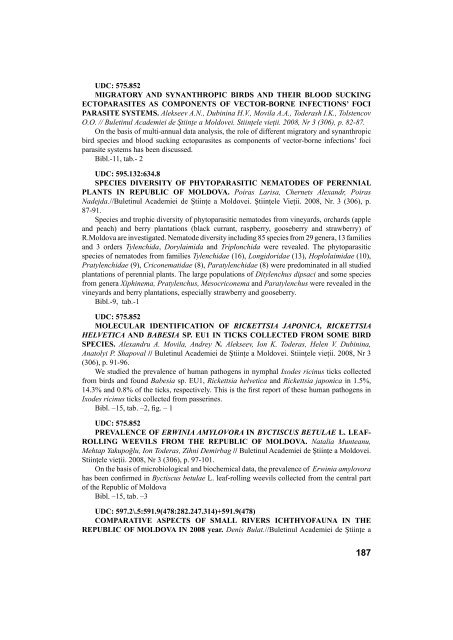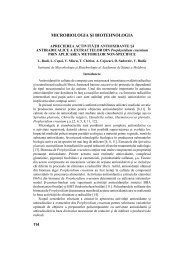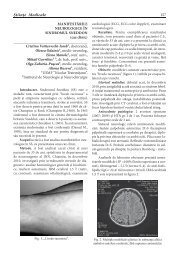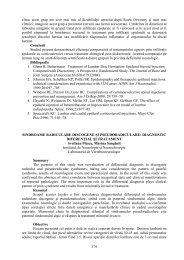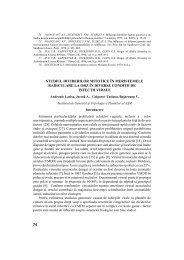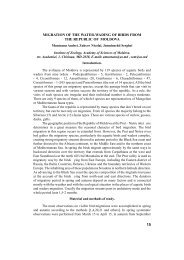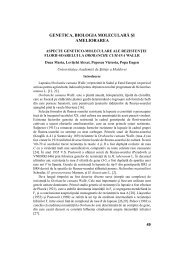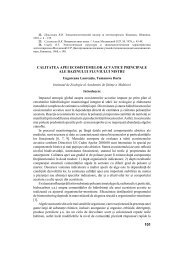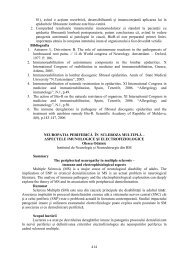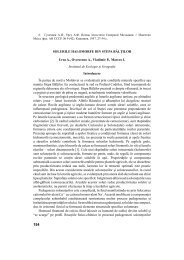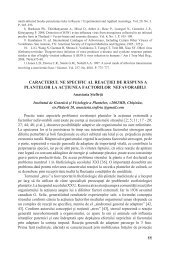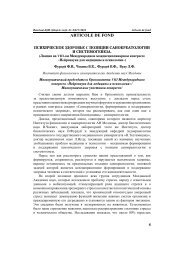198 CUPRINS
198 CUPRINS
198 CUPRINS
You also want an ePaper? Increase the reach of your titles
YUMPU automatically turns print PDFs into web optimized ePapers that Google loves.
UDC: 575.852<br />
MIGRATORY AND SYNANTHROPIC BIRDS AND THEIR BLOOD SUCKING<br />
ECTOPARASITES AS COMPONENTS OF VECTOR-BORNE INFECTIONS’ FOCI<br />
PARASITE SYSTEMS. Alekseev A.N., Dubinina H.V., Movila A.A., Toderash I.K., Tolstencov<br />
O.O. // Buletinul Academiei de Ştiinţe a Moldovei. Stiinţele vieţii. 2008, Nr 3 (306), p. 82-87.<br />
On the basis of multi-annual data analysis, the role of different migratory and synanthropic<br />
bird species and blood sucking ectoparasites as components of vector-borne infections’ foci<br />
parasite systems has been discussed.<br />
Bibl.-11, tab.- 2<br />
UDC: 595.132:634.8<br />
SPECIES DIVERSITY OF PHYTOPARASITIC NEMATODES OF PERENNIAL<br />
PLANTS IN REPUBLIC OF MOLDOVA. Poiras Larisa, Chernets Alexandr, Poiras<br />
Nadejda.//Buletinul Academiei de Ştiinţe a Moldovei. Ştiinţele Vieţii. 2008, Nr. 3 (306), p.<br />
87-91.<br />
Species and trophic diversity of phytoparasitic nematodes from vineyards, orchards (apple<br />
and peach) and berry plantations (black currant, raspberry, gooseberry and strawberry) of<br />
R.Moldova are investigated. Nematode diversity including 85 species from 29 genera, 13 families<br />
and 3 orders Tylenchida, Dorylaimida and Triplonchida were revealed. The phytoparasitic<br />
species of nematodes from families Tylenchidae (16), Longidoridae (13), Hoplolaimidae (10),<br />
Pratylenchidae (9), Criconematidae (8), Paratylenchidae (8) were predominated in all studied<br />
plantations of perennial plants. The large populations of Ditylenchus dipsaci and some species<br />
from genera Xiphinema, Pratylenchus, Mesocriconema and Paratylenchus were revealed in the<br />
vineyards and berry plantations, especially strawberry and gooseberry.<br />
Bibl.-9, tab.-1<br />
UDC: 575.852<br />
MOLECULAR IDENTIFICATION OF RICKETTSIA JAPONICA, RICKETTSIA<br />
HELVETICA AND BABESIA SP. EU1 IN TICKS COLLECTED FROM SOME BIRD<br />
SPECIES. Alexandru A. Movila, Andrey N. Alekseev, Ion K. Toderas, Helen V. Dubinina,<br />
Anatolyi P. Shapoval // Buletinul Academiei de Ştiinţe a Moldovei. Stiinţele vieţii. 2008, Nr 3<br />
(306), p. 91-96.<br />
We studied the prevalence of human pathogens in nymphal Ixodes ricinus ticks collected<br />
from birds and found Babesia sp. EU1, Rickettsia helvetica and Rickettsia japonica in 1.5%,<br />
14.3% and 0.8% of the ticks, respectively. This is the rst report of these human pathogens in<br />
Ixodes ricinus ticks collected from passerines.<br />
Bibl. –15, tab. –2, g. – 1<br />
UDC: 575.852<br />
PREVALENCE OF ERWINIA AMYLOVORA IN BYCTISCUS BETULAE L. LEAF-<br />
ROLLING WEEVILS FROM THE REPUBLIC OF MOLDOVA. Natalia Munteanu,<br />
Mehtap Yakupoğlu, Ion Toderas, Zihni Demirbag // Buletinul Academiei de Ştiinţe a Moldovei.<br />
Stiinţele vieţii. 2008, Nr 3 (306), p. 97-101.<br />
On the basis of microbiological and biochemical data, the prevalence of Erwinia amylovora<br />
has been con rmed in Byctiscus betulae L. leaf-rolling weevils collected from the central part<br />
of the Republic of Moldova<br />
Bibl. –15, tab. –3<br />
UDC: 597.2\.5:591.9(478:282.247.314)+591.9(478)<br />
COMPARATIVE ASPECTS OF SMALL RIVERS ICHTHYOFAUNA IN THE<br />
REPUBLIC OF MOLDOVA IN 2008 year. Denis Bulat.//Buletinul Academiei de Ştiinţe a<br />
187


